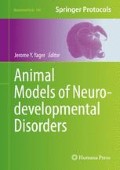Abstract
Placental insufficiency is the leading cause of intrauterine growth restriction in the western world. The fetus, when exposed to a compromised environment, is vulnerable to a number of disorders later in life, as a consequence of the reduction in oxygen and nutrition during gestation and the resulting fetal growth restriction. These conditions include neurological disabilities such as cerebral palsy (CP), intellectual disability, epilepsy, and mental health issues in childhood (Autism and ADHD) and in later life (schizophrenia). Certainly, fetal growth restriction as a result of placental insufficiency has been strongly associated with adult onset disease including cardiovascular disease, diabetes, and stroke. Current therapeutic interventions are limited, and there are no standard therapies utilized which examine prevention of these disorders, in the face of a growth restricted fetus. In this regard, models that impact the intrauterine environment are vital to the development of preclinical phenotypes that mimic human conditions. In this case, our laboratory along with several others has developed a model of placental insufficiency with fetal growth restriction and a cerebral palsy phenotype as the outcome. The result is a model that reflects mild to moderate cerebral palsy and expresses the pathologic, radiologic, and functional deficits that closely reflect that of the human, and that persist into adulthood. In addition, our group and has shown that the inherent fetal growth restriction characteristics of this model exhibits evidence of later onset adult disease. The latter findings reflect the overlap of fetal growth restriction as a risk factor for cerebral palsy. This chapter provides an informative background and the methodologies required for the development and duplication of this model of placental insufficiency in the rodent.
Access this chapter
Tax calculation will be finalised at checkout
Purchases are for personal use only
References
Robertson CM, Svenson LW, Joffres MR (1998) Prevalence of cerebral palsy in Alberta. Can J Neurol Sci 25(2):117–122
Robertson CM, Watt MJ, Dinu IA (2009) Outcomes for the extremely premature infant: what is new? And where are we going? Pediatr Neurol 40(3):189–196
Robertson CM, Watt MJ, Yasui Y (2007) Changes in the prevalence of cerebral palsy for children born very prematurely within a population-based program over 30 years. JAMA 297(24):2733–2740
Badawi N, Kurinczuk JJ, Keogh JM, Alessandri LM, O’Sullivan F, Burton PR et al (1998) Intrapartum risk factors for newborn encephalopathy: the Western Australian case-control study. BMJ 317(7172):1554–1558
Badawi N, Kurinczuk JJ, Keogh JM, Alessandri LM, O’Sullivan F, Burton PR et al (1998) Antepartum risk factors for newborn encephalopathy: the Western Australian case-control study. BMJ 317(7172):1549–1553
Jarvis S, Glinianaia SV, Torrioli MG, Platt MJ, Miceli M, Jouk PS et al (2003) Cerebral palsy and intrauterine growth in single births: European collaborative study. Lancet 362(9390):1106–1111
Jarvis S, Glinianaia SV, Blair E (2006) Cerebral palsy and intrauterine growth. Clin Perinatol 33(2):285–300
Blair E, Stanley F (1990) Intrauterine growth and spastic cerebral palsy. I. Association with birth weight for gestational age. Am J Obstet Gynecol 162(1):229–237
Blair E, Stanley F (1992) Intrauterine growth and spastic cerebral palsy II. The association with morphology at birth. Early Hum Dev 28(2):91–103
Shevell MI, Dagenais L, Hall N (2009) The relationship of cerebral palsy subtype and functional motor impairment: a population-based study. Dev Med Child Neurol 51(11):872–877
Shevell MI, Dagenais L, Hall N (2009) Comorbidities in cerebral palsy and their relationship to neurologic subtype and GMFCS level. Neurology 72(24):2090–2096
Morgane PJ, Mokler DJ, Galler JR (2002) Effects of prenatal protein malnutrition on the hippocampal formation. Neurosci Biobehav Rev 26(4):471–483
Smith GN, Flynn SW, McCarthy N, Meistrich B, Ehmann TS, MacEwan GW et al (2001) Low birthweight in schizophrenia: prematurity or poor fetal growth? Schizophr Res 47(2–3):177–184
Barker DJ (1995) Intrauterine programming of adult disease. Mol Med Today 1(9):418–423
Barker DJ, Clark PM (1997) Fetal undernutrition and disease in later life. Rev Reprod 2(2):105–112
Joss-Moore LA, Lane RH (2009) The developmental origins of adult disease. Curr Opin Pediatr 21(2):230–234, Pubmed Central PMCID: 2726974
Jacobs SE, Berg M, Hunt R, Tarnow-Mordi WO, Inder TE, Davis PG (2013) Cooling for newborns with hypoxic ischaemic encephalopathy. Cochrane Database Syst Rev 1:CD003311
Nelson KB (1988) What proportion of cerebral palsy is related to birth asphyxia? J Pediatr 112(4):572–574
Nelson KB (1989) Relationship of intrapartum and delivery room events to long-term neurologic outcome. Clin Perinatol 16(4):995–1007
Nelson KB (1991) Prenatal origin of hemiparetic cerebral palsy: how often and why? Pediatrics 88(5):1059–1062
Wigglesworth JS (1974) Fetal growth retardation. Animal model: uterine vessel ligation in the pregnant rat. Am J Pathol 77(2):347–350
Olivier P, Baud O, Evrard P, Gressens P, Verney C (2005) Prenatal ischemia and white matter damage in rats. J Neuropathol Exp Neurol 64(11):998–1006
Ke X, Schober ME, McKnight RA, O’Grady S, Caprau D, Yu X et al (2010) Intrauterine growth retardation affects expression and epigenetic characteristics of the rat hippocampal glucocorticoid receptor gene. Physiol Genomics 42(2):177–189
Schober ME, McKnight RA, Yu X, Callaway CW, Ke X, Lane RH (2009) Intrauterine growth restriction due to uteroplacental insufficiency decreased white matter and altered NMDAR subunit composition in juvenile rat hippocampi. Am J Physiol Regul Integr Comp Physiol 296(3):R681–R692
Black AM, Armstrong EA, Scott O, Juurlink BJH, Yager JY (2015) Broccoli Sprout Supplementation During Pregnancy Prevents Brain Injury in the Newborn Rat following Placental Insufficiency. Behavioural Brain Research 15;291:289–298.
Author information
Authors and Affiliations
Corresponding author
Editor information
Editors and Affiliations
Rights and permissions
Copyright information
© 2015 Springer Science+Business Media New York
About this protocol
Cite this protocol
Corrigan, J., Armstrong, E.A., Faulkner, S., Ruff, C.A., Fehlings, M., Yager, J.Y. (2015). Bilateral Uterine Artery Ligation (BUAL): Placental Insufficiency Causing Fetal Growth Restriction and Cerebral Palsy. In: Yager, J. (eds) Animal Models of Neurodevelopmental Disorders. Neuromethods, vol 104. Humana Press, New York, NY. https://doi.org/10.1007/978-1-4939-2709-8_2
Download citation
DOI: https://doi.org/10.1007/978-1-4939-2709-8_2
Publisher Name: Humana Press, New York, NY
Print ISBN: 978-1-4939-2708-1
Online ISBN: 978-1-4939-2709-8
eBook Packages: Springer Protocols

